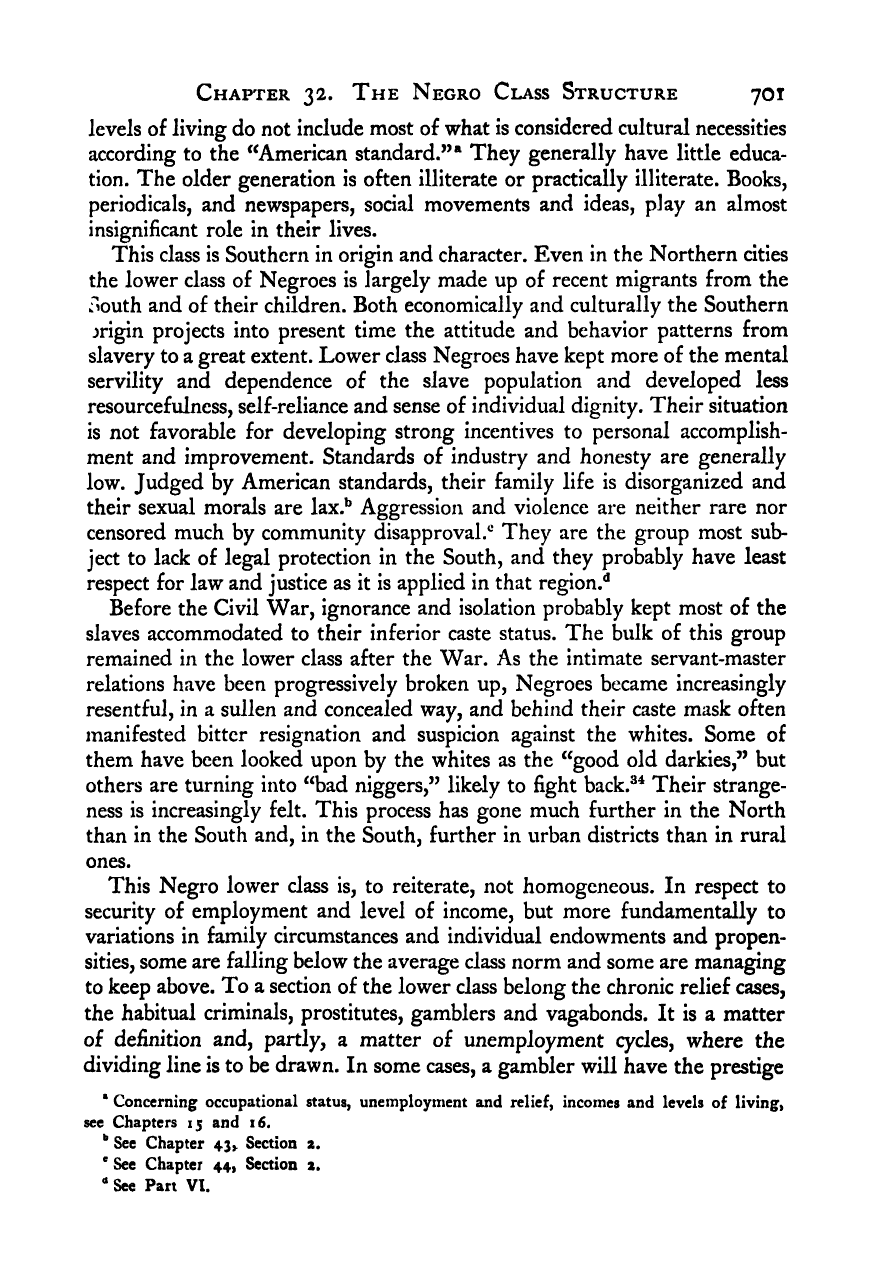Note: Gunnar Myrdal died in 1987, less than 70 years ago. Therefore, this work is protected by copyright, restricting your legal rights to reproduce it. However, you are welcome to view it on screen, as you do now. Read more about copyright.
Full resolution (TIFF) - On this page / på denna sida - VIII. Social Stratification - 32. The Negro Class Structure - 4. The Classes in the Negro Community

<< prev. page << föreg. sida << >> nästa sida >> next page >>
Below is the raw OCR text
from the above scanned image.
Do you see an error? Proofread the page now!
Här nedan syns maskintolkade texten från faksimilbilden ovan.
Ser du något fel? Korrekturläs sidan nu!
This page has never been proofread. / Denna sida har aldrig korrekturlästs.
Chapter 32. The Negro Class Structure 701
levels of living do not include most of what is considered cultural necessities
according to the ^^American standard.”* They generally have little educa-
tion. The older generation is often illiterate or practically illiterate. Books,
periodicals, and newspapers, social movements and ideas, play an almost
insignificant role in their lives.
This class is Southern in origin and character. Even in the Northern cities
the lower class of Negroes is largely made up of recent migrants from the
South and of their children. Both economically and culturally the Southern
origin projects into present time the attitude and behavior patterns from
slavery to a great extent. Lower class Negroes have kept more of the mental
servility and dependence of the slave population and developed less
resourcefulness, self-reliance and sense of individual dignity. Their situation
is not favorable for developing strong incentives to personal accomplish-
ment and improvement. Standards of industry and honesty are generally
low. Judged by American standards, their family life is disorganized and
their sexual morals are lax.** Aggression and violence are neither rare nor
censored much by community disapproval.** They are the group most sub-
ject to lack of legal protection In the South, and they probably have least
respect for law and justice as it is applied in that region.^
Before the Civil War, ignorance and isolation probably kept most of the
slaves accommodated to their inferior caste status. The bulk of this group
remained in the lower class after the War. As the Intimate servant-master
relations have been progressively broken up, Negroes became increasingly
resentful, in a sullen and concealed way, and behind their caste mask often
manifested bitter resignation and suspicion against the whites. Some of
them have been looked upon by the whites as the ‘^good old darkles,” but
others are turning into “bad niggers,” likely to fight back.^^ Their strange-
ness is increasingly felt. This process has gone much further in the North
than in the South and, in the South, further in urban districts than in rural
ones.
This Negro lower class is, to reiterate, not homogeneous. In respect to
security of employment and level of income, but more fundamentally to
variations in family circumstances and individual endowments and propen-
sities, some are falling below the average class norm and some are managing
to keep above. To a section of the lower class belong the chronic relief cases,
the habitual criminals, prostitutes, gamblers and vagabonds. It is a matter
of definition and, partly, a matter of unemployment cycles, where the
dividing line is to be drawn. In some cases, a gambler will have the prestige
Concerning occupational status, unemployment and relief, incomes and levels of living,
see Chapters 15 and 16.
^ See Chapter 43^ Section 2.
See Chapter 44, Section 2.
“ See Part Vl.
<< prev. page << föreg. sida << >> nästa sida >> next page >>